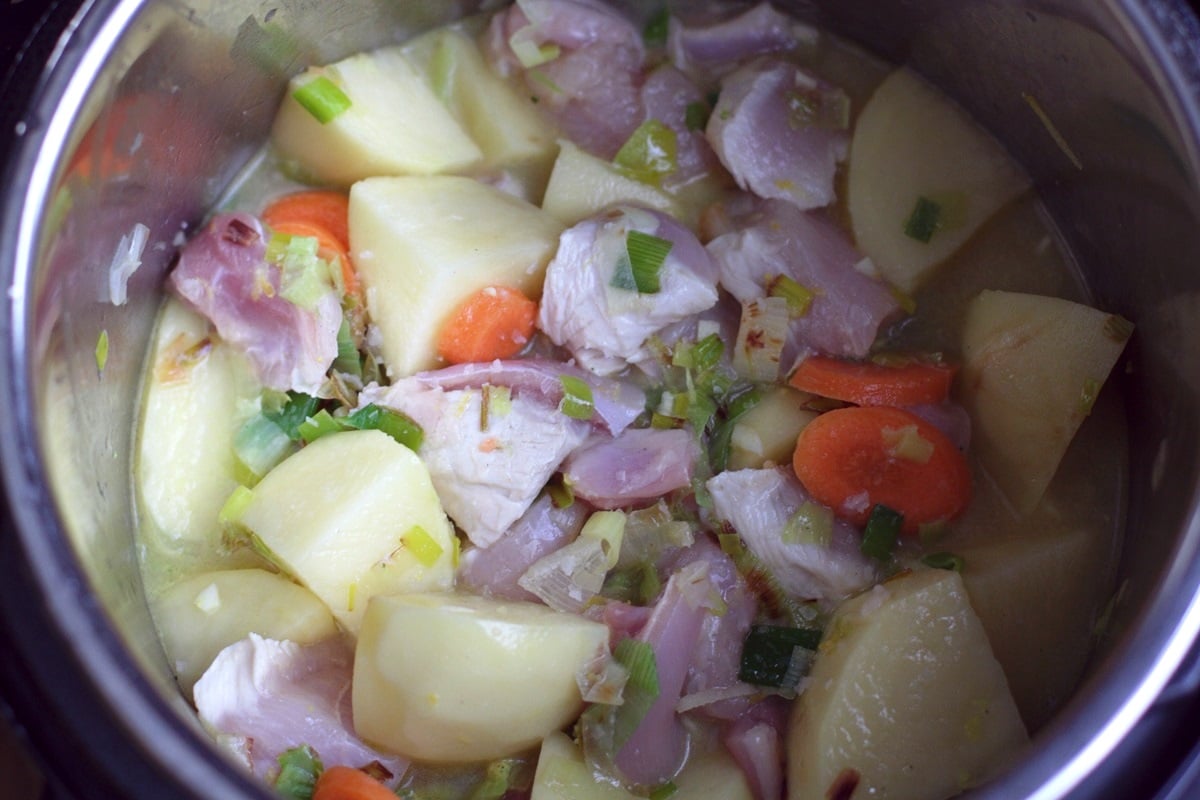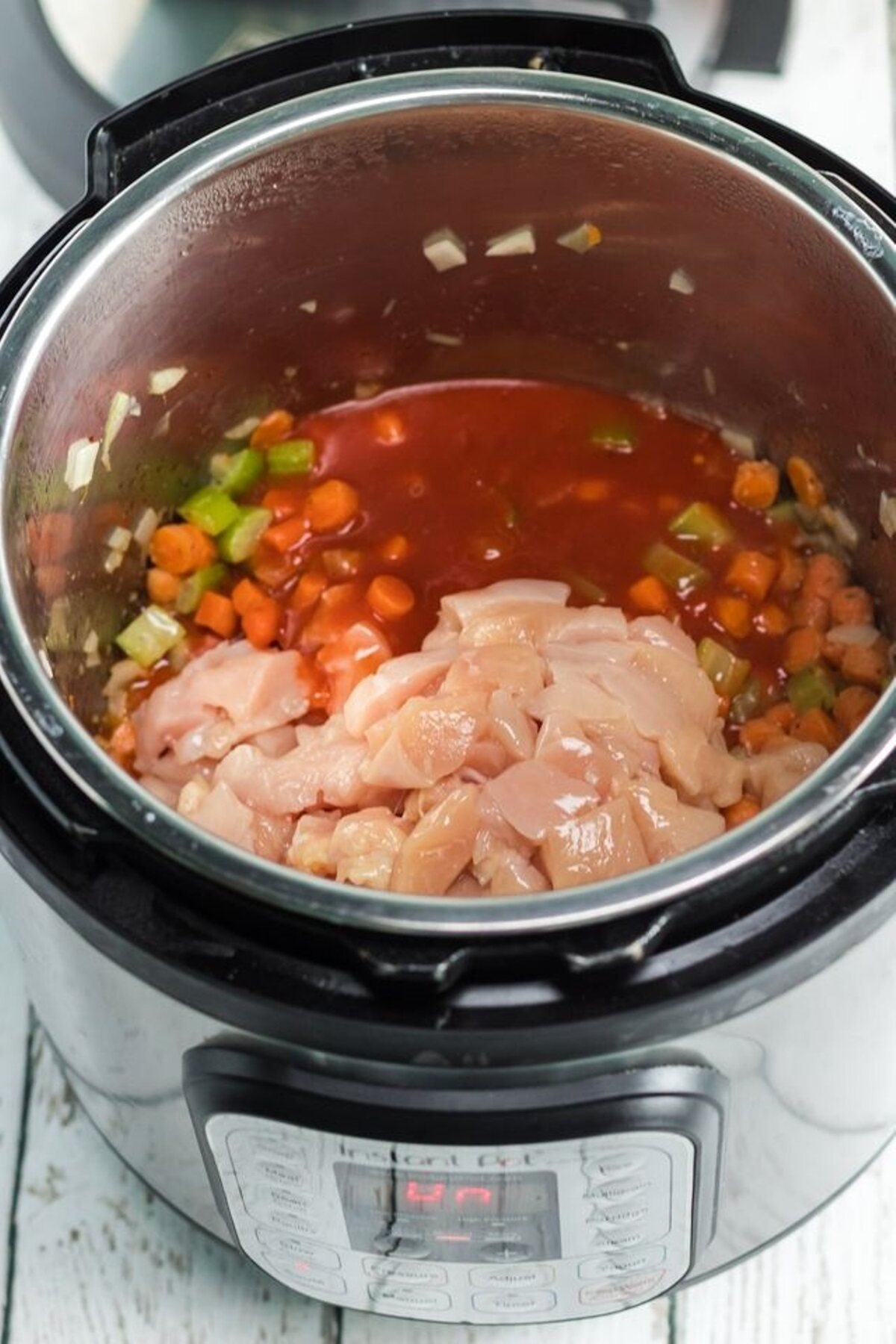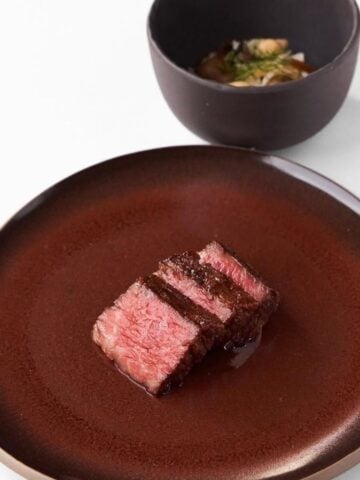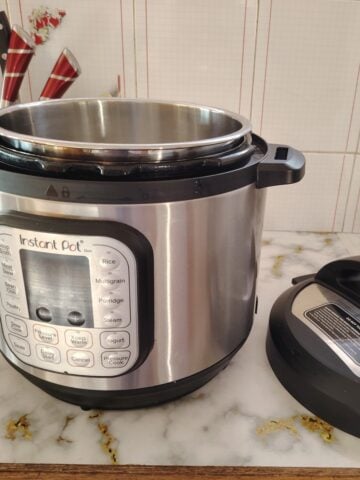
So, you’ve fallen in love with your Instant Pot, and now you’re ready to cook for more people—or maybe you just want leftovers for the week. Whatever the reason, doubling an Instant Pot recipe is a smart move, but it can also be a bit tricky if you don’t know how to adjust things. Luckily, I’ve got your back with this guide on how to double an Instant Pot recipe successfully.
You might be wondering: Does doubling the recipe mean doubling the pressure cooking time? Or do you just toss in twice as many ingredients and hope for the best? Let’s get into the ins and outs of pressure cooking when you want to make a double batch, and I’ll show you how to avoid common pitfalls below:
Jump to:
- Can You Really Double an Instant Pot Recipe?
- Golden Rules for Doubling an Instant Pot Recipe
- How Doubling Affects Cook Times for Different Ingredients
- Quick Release vs. Natural Pressure Release (Natural Release)
- Instant Pot Size: Is Bigger Better?
- Tips for Doubling Instant Pot Recipes and Avoiding Mistakes
- FAQ's
- Conclusion
Can You Really Double an Instant Pot Recipe?
Yes! You can double an Instant Pot recipe—but there are a few important things to keep in mind to make sure it turns out just as delicious as the original. Unlike stovetop cooking, where you can just double the ingredients and the cook time, pressure cooking is a little more nuanced.
Doubling a recipe in the pressure cooker is all about the quantity and ratios of ingredients. You’ll need to adjust the cooking time, the amount of liquid, and sometimes the order in which things go into the pot. But don’t worry, it’s definitely doable!
Golden Rules for Doubling an Instant Pot Recipe

Before you start dumping twice as much of everything into your Instant Pot, there are a few golden rules to keep in mind:
1. Don’t Double Everything
Just because you’re doubling the recipe doesn’t mean you should double everything. You’ll need to adjust the ingredients and avoid overloading the pot with so much liquid or seasoning.
- Liquid: When doubling, you might think you need to double the amount of chicken stock or broth, but that’s usually not the case. Most recipes only require a little bit of liquid to build pressure, and too much can cause the pot to struggle to reach pressure or even trigger a burn notice.
- Spices & Seasoning: This one is important! Spices intensify during pressure cooking. For example, if a recipe calls for 1 teaspoon of salt, don’t double it to 2 teaspoons. Start with 1.5x the amount and adjust after cooking if needed.
2. Follow the Fill Line
Your Instant Pot has a max fill line that you need to respect, and you can’t go beyond it. It’s generally safe to fill your Instant Pot to ⅔ of its capacity for most recipes, and for foamy or starchy dishes (like rice or pasta), you should only fill it halfway.
If you’ve got a 6-quart Instant Pot and want to double a recipe designed for a smaller batch, make sure there’s enough room in the pot to allow for proper pressure cooking. If you have an 8-quart Instant Pot, you’re in luck because you have more space to work with!
3. Adjust the Cooking Time
Here’s the big question: When you double a recipe, do you double the pressure cooking time? The answer is no. You generally won’t need to increase cooking time when doubling an Instant Pot recipe. The pressure cooking process works a little differently than cooking on the stove or in the oven.
For example, if your Instant Pot recipe for beef stew calls for 35 minutes of cooking time, doubling the ingredients won’t necessarily double the time.
While the pot will take longer to build pressure (due to the increased volume), the cooking time itself stays the same. Keep in mind that larger cuts of meat, like pot roast or corned beef, may need a bit longer—but even then, only by a few minutes.
Check out our 35 Authentic Italian Dinner Ideas here.
How Doubling Affects Cook Times for Different Ingredients

The principle applies to most recipes. The size and thickness of the food matter more than the quantity when it comes to pressure cooking. Here are a few tips based on common recipes:
Meats & Poultry
- Chicken, Beef, Pork: The cooking time for meats doesn’t double with the amount. If you’re cooking chicken, for example, 2 chicken breasts take the same cooking time as 4 or 6, assuming they are similar in size. If you’re making a pot roast, you may need to adjust based on thickness. Searing in batches helps with even cooking, too.
Rice & Beans
- Rice: Rice doesn’t follow the same rules as meat, but doubling rice is still easy. If you’re making basmati rice, you’ll want to keep the 1:1 ratio of water-to-rice, even if you’re cooking more rice. The key is to avoid really mushy basmati. The pressure cooking time for rice remains the same, but the Instant Pot will take longer to build pressure when you have more rice and liquid.
- Beans: When doubling beans, be careful with the liquid. Beans need enough liquid to cook, but doubling the beans doesn’t always mean doubling the water. You may only need to add an extra ½ to 1 cup of water. If you’re cooking beans from dry, consider adding a few extra minutes to the pressure cooking time.
Soups & Stews
For soups and stews, you can typically double the ingredients with very little adjustment. Just ensure that the liquid is enough for the Instant Pot to reach pressure. If you’re adding more veggies or meat, just make sure that the total volume doesn’t exceed the max fill line.
Check this out: 41 Hearty Soups and Stews
Quick Release vs. Natural Pressure Release (Natural Release)
Now that you’ve got your double batch cooking away in the Instant Pot, it’s time to decide how to release the pressure. For a double batch, especially with thicker dishes like stew or soup, a natural release is often best. The pressure cooker continues to cook the food a little bit even after you turn it off, and letting the natural release happen can help with texture and flavor.
If you’re in a rush or cooking something delicate like chicken, you may prefer a quick release. But when you’re cooking a double batch, the natural pressure release gives the ingredients more time to settle and helps avoid overcooking, especially for meats like corned beef or pot roast.
Instant Pot Size: Is Bigger Better?
If you’re using an 8-quart Instant Pot, you’ll find it much easier to successfully double most recipes. However, if you’ve only got a 6-quart, you’ll need to be more careful about the amount of ingredients you add. Going over the fill line can cause the lid to pop open or trigger safety alarms.
If your recipe calls for a steamer basket, for example, make sure you don’t crowd it. The steamer basket can help when making a double batch of things like pasta or veggies, as it keeps food separated and helps even pressure cooking occur.
Tips for Doubling Instant Pot Recipes and Avoiding Mistakes

Don’t Double the Thickening Agents
If your Instant Pot recipe includes something like cornstarch to thicken the sauce, don’t double it! You could end up with a sauce that’s too thick or even cause a burn notice.
Keep an Eye on the Liquid
Make sure there’s enough liquid to create pressure, but don’t go overboard. Too much can cause issues with pressure cooking and mess with the flavor balance. Stick to what the recipe suggests and adjust if necessary.
Consider Splitting the Recipe
If you have a 6-quart pot and the recipe calls for a double batch, consider making two separate batches. If you really want to cook it all at once, an 8-quart Instant Pot would be your best friend.
Freeze Leftovers
Doubling a recipe is a great way to freeze extra portions for later. Once your Instant Pot recipe is cooked, portion out the leftovers and store them for future meals.
FAQ's
Generally, you don’t need to decrease pressure cooking time when doubling a recipe in your Instant Pot. The cook time for pressure cooking remains the same because the Instant Pot adjusts its internal heat to cook the food equally. However, keep in mind that with a double batch, the Instant Pot will take a bit longer to build pressure, so the overall cooking time may feel longer. If you find that the cooking time needs fine-tuning for specific ingredients, feel free to adjust in advance, but for the most part, other recipes can follow the same principle of cooking time regardless of batch size.
No, doubling the ingredients in an Instapot recipe is not quite the same as using a slow cooker. A slow cooker typically requires more time to heat the ingredients, whereas the Instant Pot uses pressure cooking to cook the food much faster. When you double the ingredients in the Instant Pot, the pressure cooker will still cook at the same pressure cooking time, but it may take a little longer to build pressure. The main difference is that the Instant Pot cooks much faster than an old fashioned PR cooker, so you’ll get the same results without the long wait.
When doubling a recipe, it’s crucial not to overcrowd the pot. The Instant Pot works best when there’s room for more items to cook properly. If you try to cook more ingredients than the pot can handle, it can affect the heat distribution and prevent the Instant Pot from reaching pressure. If you find yourself adding too many ingredients, try cooking half of the recipe at a time or use a larger model like the 8-quart Instant Pot for a double batch. This way, the food will cook evenly, and you’ll avoid any issues during the cooking process.
Yes, you can make an Instant Pot recipe with more ingredients than it originally calls for, but there are a few things to consider. First, make sure you respect the fill line to prevent the pot from malfunctioning. When adding more items, like vegetables or meats, ensure the pressure cooker has enough liquid to reach pressure. You may need to adjust the cooking time slightly depending on the size and density of the ingredients. If you’re unsure, it’s always fine to cook in advance and make the recipe with smaller batches to avoid complications.
If your food comes out too cool after pressure cooking, there’s a simple solution! The most common reason is a quick release of pressure, which can cause the Instant Pot to lose heat. Instead of using quick release, try allowing a natural release to help maintain heat in the pot. If you’ve already done a quick release and the food isn’t as hot as you’d like, you can simply turn the Instant Pot back to sauté mode for a minute or two to reheat the food equally. This should do the trick, but for next time, using natural release is a great way to keep your meal at the right temperature.
Conclusion
Doubling an Instant Pot recipe is all about following a few key principles. By adjusting your liquid amounts, not doubling spices and seasonings, and respecting the fill line, you’ll be able to make a double batch that turns out just as delicious as your original recipe! Happy pressure cooking!










Leave a Reply